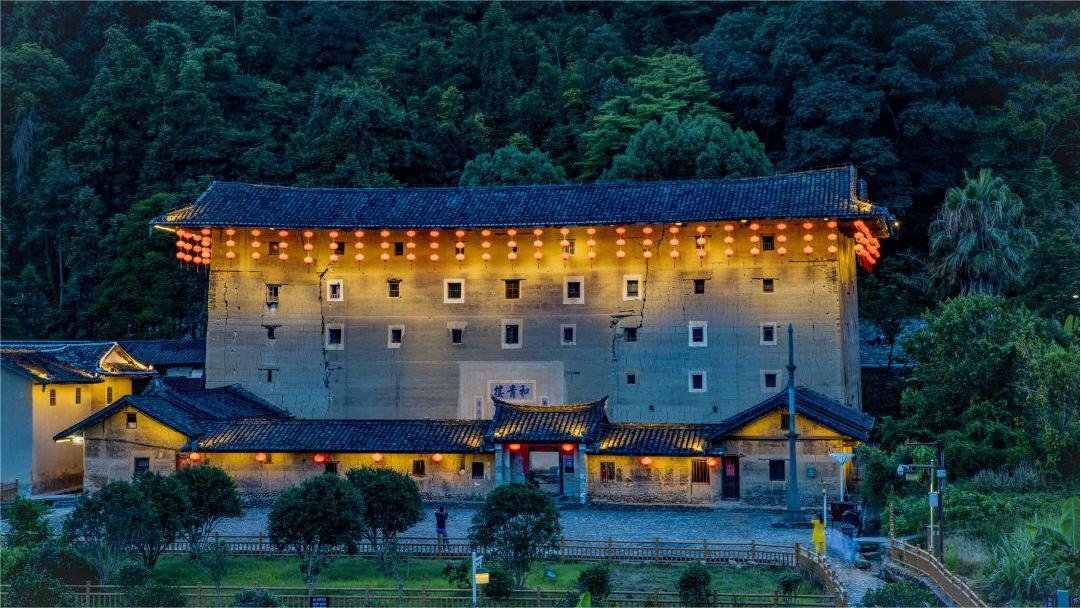Heguilou (和贵楼, Hegui Earth Biuilding), also known as “Shanjiaolou (山脚楼),” is a renowned Hakka earth building located in Puxian Village, Nanjiang County. Built in the 10th year of the Yongzheng era during the Qing Dynasty (1732 AD) by the local gentleman Jian Ciping, Heguilou represents a quintessential example of the unique architectural style of Fujian’s traditional earthen buildings. This historical structure was constructed with a substantial investment of 15,000 taels of silver, making it not only a significant cultural and historical monument but also a marvel of ancient engineering.
Heguilou stands at a towering height of 21.5 meters (70 feet), making it the tallest known Fujian Tulou, or earthen building, in existence. The building covers an area of 1,547 square meters and has a total floor area of 6,450 square meters. Its five-story design includes 28 rooms on each level, totaling 140 rooms across the entire structure. The building’s grandeur is evident in its massive scale and impressive architectural complexity.
The Tulou’s design follows a traditional round or square shape, but Heguilou is notable for its rectangular layout and the symmetrical arrangement of its elements. A central entrance gate leads into the building, with stairways located on each of the four cardinal directions (east, west, south, and north) to facilitate movement between floors and around the building. This design ensures that inhabitants could easily access different sections of the building and maintain a degree of privacy and security.
Table of Contents
- Basic Information
- Location and Transportation
- The “Three Wonders” of Heguilou
- Other Earthern Buildings in Nanjing
Basic Information
| Estimated Length of Tour | 1 hour |
| Ticket Price | 90 RMB including Yunshuiyao Anicent Town, Huaiyuanlou, and Heguilou |
| Opening Hours | 8.00 – 18.00 |
| Telephone Number | 0086-4008885111 |
Location and Transportation
Heguilou, also known as “Shanjiaolou,” is located in Puxian Village, Meilin Town, Nanjing County, Fujian Province, China. It is approximately 53 kilometers from Nanjing County town. To get there, you can choose one of the following ways:
- Take a train to Nanjing Railway Station. From the station, exit and look for tourist buses waiting outside. Buses depart approximately every hour, costing around 20 yuan per person. The journey takes about 1.5 hours.
- Alternatively, you can take a bus to Nanjing Bus Station and transfer to a specialized Tulou shuttle service. These buses also cost about 20 yuan per person and depart regularly for Heguilou.
The “Three Wonders” of Heguilou
The Tallest Earth Building
Heguilou’s height of 21.5 meters is the tallest of all the traditional Fujian Tulou structures. This remarkable height not only distinguishes it from other earthen buildings but also serves as a testament to the architectural ingenuity of its creators. The building’s significant height, combined with its vast internal space, showcases the advanced construction techniques used during the Qing Dynasty.
The Mysterious Sinking and Stabilization
One of the most intriguing aspects of Heguilou’s construction is the tale of its sinking and stabilization. During its construction, the building began to sink into the marshy ground after the first floor was completed, resembling a “sinking ship.” To counteract this problem, the builders drove over 100 cubic meters of timber piles into the ground to stabilize the foundation. This remarkable engineering feat allowed the builders to continue construction and complete the building to its current height, demonstrating both the challenges and successes of traditional Tulou construction methods.
The Two Wells
Heguilou is home to two wells situated 18 meters apart from each other, each with distinct characteristics. The left well contains clear, sweet water and is home to several red koi fish, creating a picturesque and serene environment. In contrast, the right well contains muddy, unfit-for-drinking water. This fascinating contrast between the two wells arises from their different construction materials and methods. The clear water well was built with cement, resulting in fewer gaps and less water infiltration from the marshy layers, while the muddy well was constructed with small round stones, leading to greater water contamination. This natural phenomenon highlights the differences in water quality and offers a unique insight into the local hydrological conditions.




